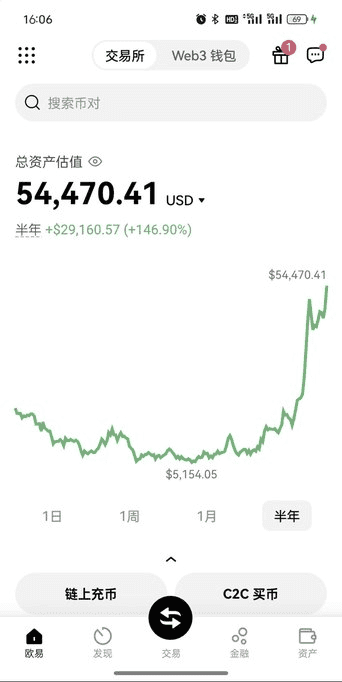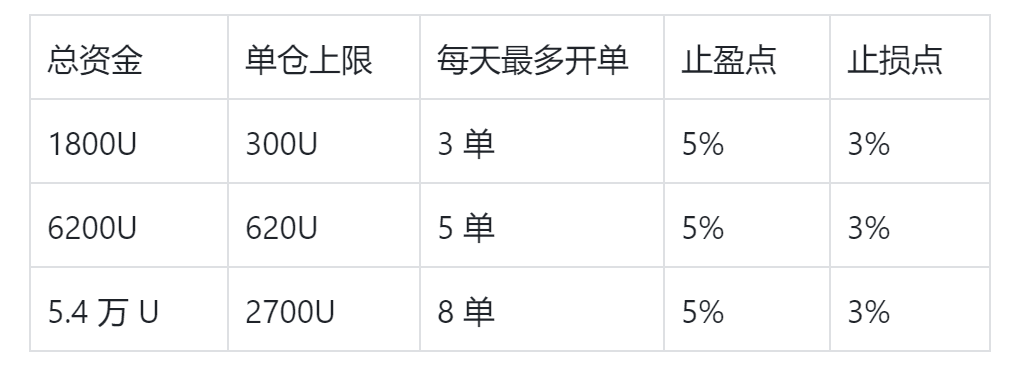On the day I paid off my credit card bill of 1800U in August 2020, I stared blankly at the amount in my account. After losing all my savings in the first three liquidations, my wife said, 'If you play with cryptocurrency again, I'll divorce you.' Now, this little money I have is secretly saved pocket money; I have to budget even for buying a pack of cigarettes.
At that time, the group was shouting 'ETH must break 1000 dollars.' Some showcased their profit using 20x leverage, with glaring red numbers that hurt the eyes. I deleted all the signal groups, split 1800U into six parts, each 300U—this was my last chance. If I got liquidated again, I would be completely out of the cryptocurrency world.
My account is now locked at 54230U. Every morning I open trades, walk the dog, and review at night, living more regularly than at work. I haven't touched 20x leverage even once in these three years, haven't chased a single surging altcoin, and hardly even look at groups. Others say I'm 'too conservative,' but they don't know: the real profits in cryptocurrency lie in the four words 'resist the urge to gamble.'

Stage 1: From 1800U to 6200U, using the '300U trial-and-error method' to avoid 90% of the pitfalls.
During my first allocation operation, I wrote a strict rule in my notebook: profit 3%-5% per trade and exit, never be greedy.
The first trade of 300U bought BTC at a price of 9800; I set a take-profit at 10200 (4% profit). The next morning, I got a notification saying 'position closed, profit 12U.' Some in the group criticized me for 'thinking too small; it could at least go up to 11000,' but I turned around and used another 300U to buy ETH, withdrawing as soon as I made 4%.
At the end of the first week, I operated six funds in rotation, with a total profit of 420U. The most crucial thing is that I haven't lost a single trade—because I only trade 'small breakouts after consolidation':
Wait until BTC stays flat between 9800-10000 for three days, confirming it has stabilized before buying.
Set take-profit orders in advance; they execute automatically at the designated time, so I don't have to stare at real-time market conditions.
If it drops, wait for the next wave; never average down. If this one doesn't work, move on to the next.
In the third week, ETH suddenly jumped 15%, and the group was frantically increasing positions, but I followed the rule and cleared my position at a 5% profit. That night, ETH corrected 8%, and those who were fully invested lost heavily, while my account quietly rose to 6200U.
I finally understood: in cryptocurrency, 'surviving' is more important than 'charging forward.' While others think about making back their capital in one go, I use a 'small spoon' of 300U to gradually fatten my account.
Stage 2: From 6200U to 23,000 U, relying on 'picking up bargains when others panic' to harvest inversely.
In May 2021, the LUNA crash led to a market plunge, with BTC dropping from 40,000 to 28,000. The group was in despair, and as some were cutting losses and leaving, I opened my allocation table:
Split 6200U into 10 parts, each part 620U.
Only choose mainstream coins that have 'dropped more than 30%' (BTC, ETH, BNB)
Buy one part every time it drops 5%, do not try to bottom out all at once.
When BTC fell to 28,000, I bought my first 620U; when it dropped to 26,000, I bought the second; it fell to a low of 24,000, and I bought a total of four portions. The average cost was 26,000 dollars, and when it rebounded to 32,000, the four positions made a profit of 1800U.
What's more important is the rhythm of taking profits:
Sell 20% when earning 10%, for example, if 6200U rises to 6820U, sell 1200U first to secure profits.
When it rises to 7500U, then sell 1500U.
Leave the remaining 50% to follow the trend, but set a trailing stop (move stop up 3% every time it rises 5%).
In this way, amidst the cycle of panic selling and greedy chasing by others, I relied on 'buying low + taking profits in batches' and earned 500-1000U daily for nine days, pushing my account to 23,000 U. Once a neighbor asked me, 'How do you always buy at the low point?' I said, 'I never wait for the lowest point; I only buy when others are too scared to.'
Stage 3: From 23,000 U to 54,000 U, the more I earn, the more cautious I become, and I end up going further.
The day my account surpassed 23,000 U, I spent 200 bucks on a script tool that does one thing: automatically placing orders, completely saying goodbye to manual operations.
Only place trades for these four coins: BTC, ETH, SOL, OP.
Set the buy price to 'current price drops 3%' and the sell price to 'buy price rises 5%'
No single trade should exceed 5% of total capital (for example, with 23,000 U, the maximum single position is 1150U)
After the script ran for three months, I would check the transaction records each morning, walk the dog during the day, and review at night, completely ignoring real-time market conditions. One time, SOL suddenly surged by 20%, and the script sold automatically at a 5% increase, missing out on quite a bit, but I didn't feel bad at all—because if I had operated manually, I might have been greedy and not sold, ending up with a loss when it corrected.
This is the difference between retail investors and winners: retail investors rely on feelings to make quick money, while winners rely on rules to make steady money. I've seen too many people make 50,000 from 20,000, only to lose it back down to 10,000; what they lack is not skills, but the patience to 'take profit when it's good.'
4. Three 'clumsy habits' that prevent me from getting liquidated are more effective than any indicator.
Now, every day before the market opens, I do these three things and have stuck with it for three years:
1. The allocation table must be filled; otherwise, I won't open a trade.

Every time the capital increases, I first update the allocation table; the single position limit rises accordingly, but the ratio never exceeds 5%-10%. This table acts like brakes, preventing me from recklessly increasing positions because I've 'made too much.'
2. Withdraw 30% of the profit to spot the same day.
For example, if I made a profit of 1000U today, I would immediately transfer 300U to buy BTC spot; this portion remains untouched forever. As of now, the BTC in my spot account is worth 18,000 U, and even if the contract gets liquidated, this portion is still my bottom line—betting with profits is always more secure than betting with principal.
3. If I make two consecutive profits, I stop for half a day.
When things are going smoothly, it's easy to get carried away; I've learned this the hard way. In 2021, I made five consecutive profitable trades, got too excited, and leveraged my position, resulting in a loss of 3000U. Now I've set a rule: after two consecutive profits, I close the software and take the dog for a walk, waiting to calm down before trading again.
5. Three pieces of solid advice for 1800U players.
From 1800U to 54,000 U, what I want to tell beginners is:
Don't believe in the myth of 'one-time turnaround': I used 300U to earn for three years, rolling it up to 54,000. Those who say '1800U can turn into 180,000' are either scammers or gamblers.
Change 'how much I want to earn' to 'how much I can afford to lose': before opening a trade, first calculate, this trade can lose a maximum of 15U; if acceptable, proceed; if not, wait. Losing 15U from 1800U doesn't hurt, but losing 1800U means there's no chance left.
Find a 'watching clock': check the market only at fixed times each day (like 8 AM and 8 PM), deleting the software during other times. I tried not looking at the market for three consecutive days, and my account actually earned more than when I was watching all the time.
In the next market wave, I will guide my students to fill out the 'allocation table,' starting from 1800U, and only doing three trades a day. Those who want to escape the 'liquidation cycle' can follow me—behind the 54,000 U account, there is no magical strategy, just three years of patience without making random trades.
Remember: The person who goes furthest in cryptocurrency isn't the one who runs fastest, but the one who knows how to slow down during craziness. Your self-control is your most valuable asset.



